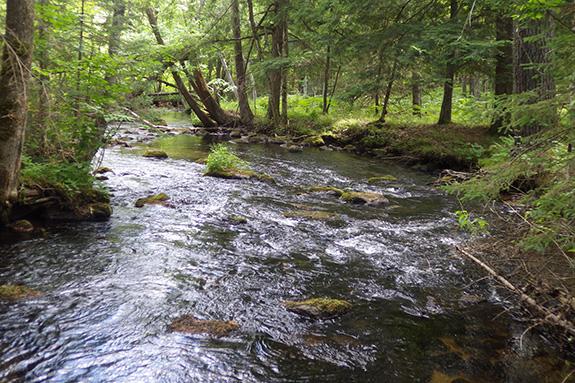Summer is at its fullest this time of year. Long days filled with bright sunlight warm our trout streams to temperatures levels uncomfortable for trout, despite the occasional rainy days. Brook trout having evolved under these conditions are very adept at seeking up-welling springs and cold ground-water seeps within streams that offer a cool refuge.
Sometimes it is in the midafternoon hours that brookies seek shelter; however, during extended heat waves thermal refuges ensure survival in an otherwise uninhabitable stream. Fishers realize fishing under such conditions can be lethal to trout due to the stresses caused by catching and handling, even under the most careful means. This does not necessitate fishers abandon trout fishing in mid-summer, but to make an adjustment in geography.
Turn north to the dense woods of the northern counties where streams sheltered under a tall canopy of basswood, pine, hemlock, and maple trees remain shaded and cool to harbor brook trout. Several days ago I returned to a favored northern stream in search of brookies. The stream followed a course established long ago among large moss covered boulders and descended a steep decline into an open fern glade among trunks of massive trees. Its impressive depth and coldness remained hidden until experienced by wading waist deep.
In some places it was almost as deep as wide though narrow cutes. A refreshing breeze moved downstream, cooled by the tumbling water, carrying the musky fragrance of wetted moss and fern. Phlox expressed their soft blue beauty in dappled sunlight among sedges and ferns clinging to the bank in contrast to the amber tannin stain of the water.
Sometimes it is hard to start fishing surrounded by such beauty, while fishing is the reason for being there. It makes sense though to start fishing with an appropriate fly, a fly pattern that is native to northern counties. The classic Earl Paape Pass Lake Fly fitted this situation well.
The history of the Pass Lake Fly is well documented by authors describing its relationship within families of fishers and the streams and lakes where it was fished for decades. The first cast, mended to float the fly into a pool, showed the brook trout acknowledged that the correct fly was selected. The size of the brookie was not important. The vibrant colors and the vigor of the encounter in this particular stream was the prize.
So much of the nature of trout streams is about relationships. It is about our place with trout streams, understanding when to be within them and when to just be the observer of their intrinsic beauty. The best happens when we can do both; being within the stream among its constituents and being patient with yourself to enable enough time to take it all in. In this trip I got both.
It did not matter how many brookies were caught and the fact they also liked three other fly patterns. It was selecting the right fly, on the first cast, on a special stream, under brook trout conditions and in a beautiful setting.
Our Central Wisconsin trout streams have their own unique beauty. When mid-summer temperatures are too warm for trout to be exercised safely, we can still visit them. Be the observer, recall past shared experiences and be in relationship with our streams.


